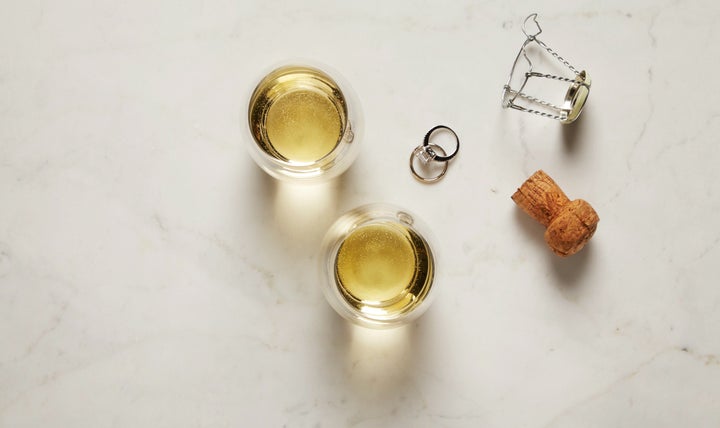
It’s official—you’ve said yes and your phone is pinging off the hook with Facebook likes. It’s time to pop open some bubbly. Now that the Champagne is flowing, let’s drop some knowledge and debunk the top five myths surrounding your new sustaining life force until you say the words, “I do.”
1. Myth: Opening champagne should be a show
The only dangerous myth on this list that needs to be debunked is that opening Champagne—or any sparkling wine for that matter—should be a loud, frothy spectacle. While those scenes look oh-so-glam on TV, in real life it could result in taking out someone’s recently engaged eye. There are several things one should do to open Champagne correctly: First, chill the bottle down to about 45 degrees by placing the bottle in the refrigerator for a minimum of 15 minutes (a warm bottle is more likely to explode). Second, take the foil off carefully and cover the cork with a kitchen towel, keeping your palm over the top the entire time. Third, use your other hand to slightly twist the bottle-not the cork. This should ease the cork out slowly. You’ll hear a slight “pufft” when it’s open, and voila you’ve just started the party (safely)!
2. Myth: Champagne flutes are a must
Who doesn’t love holding up a long-stemmed tulip filled with fizzy juice? Flutes have been traditionally used for enjoying Champagne and sparkling, and for a reason—they are lovely. However, there is no benefit to using them from a taste perspective. In fact, their shape—tall, lean, with a narrow opening—limits your ability to swirl and smell. Many Champagne brands have actually shifted their official glassware from flutes to white wine stemware because the latter better expresses Champagne’s complex aromas and flavors. So, while Champagne flutes are fancy AF, they are certainly not required, and in many cases, a classic white wine glass is preferred.
3. Myth: Champagne gives you a bad hangover
One of the most common (and frustrating) myths about Champagne is that it gives you a terrible hangover. What many don’t realize is that alcohol type has nothing to do with your morning headache; rather, it’s how much you drink and not what you drink. And if you’ve read those few floating studies that purport carbon dioxide in Champagne helps get alcohol into your bloodstream faster, that theory has yet to be proven—not to mention, it has nothing to do with your hangover symptoms. Still, if you feel Champagne gives you a bad hangover, try drinking less of it, or better yet, alternate between a glass of sparkling water and bubbly, and call me in the morning.
4. Myth: Champagne is only for celebratory occasions
There’s no argument here—Champagne really is the perfect pour to celebrate your nuptials, whether it’s to get your bachelor/ette party going or for heartfelt toasts on your big day. However, the fun doesn’t have to stop there. Champagne is actually a perfect wine for pairing with food anytime of year, for any occasion. It is a high-acid wine that’s balanced out by a subtle sweetness. That acidity, and the refreshing effervescence, pairs perfectly with high-fat fried foods, like French fries and fried chicken, because it washes your palate clean. The subtle sweetness on the other hand is a wonderful complement to Asian cuisines, such as sushi, Thai or even Chinese takeout. What a fab way to Netflix and chill during your happily ever after!
5. Myth: The best sparkling wine is from champagne
This is a big one. Champagne and sparkling wine are different. Here’s the scoop: The Champagne region in France is where the wine’s founding fathers first “saw stars” in their glass in the 17th century, and developed what’s now called méthode champenoise. This method, by which all true Champagne is made, starts with a still wine that then goes into a second fermentation in the bottle. These bottles are rotated slowly over a long period of time while upside down to collect yeast in their necks. This yeast is eventually released and sugar is simultaneously added before corking the bottles. Méthode champenoise is arguably the most labor-intensive winemaking process resulting in the highest-quality sparkling. It shares very little with the standard sparkling process, in which the second fermentation occurs in a steel tank.
While this method was invented in Champagne, it is used around the world to make wines of nearly the same caliber with significantly lower price tags. That means that you don’t need to pay big bucks for great quality. Just check the back of the label for “méthode champenoise” or “méthode traditionelle,” and you’ve got some Champ-status juice to pop at your engagement party!
Looking for more wedding beverage etiquette or to set up a wine, spirits & drinkware registry? Visit us at ThirstyNest.com - the first expertly curated beverage registry for the modern couple.